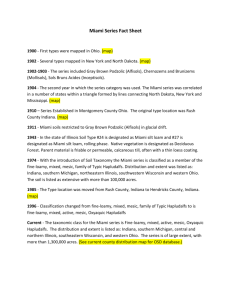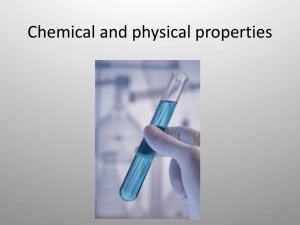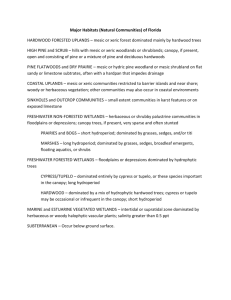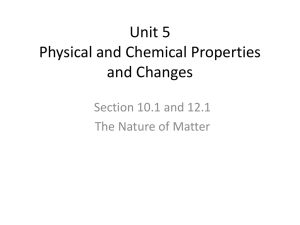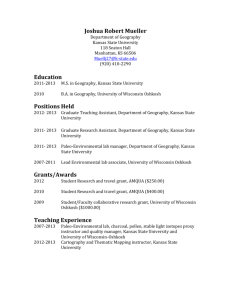Document 13272770
advertisement
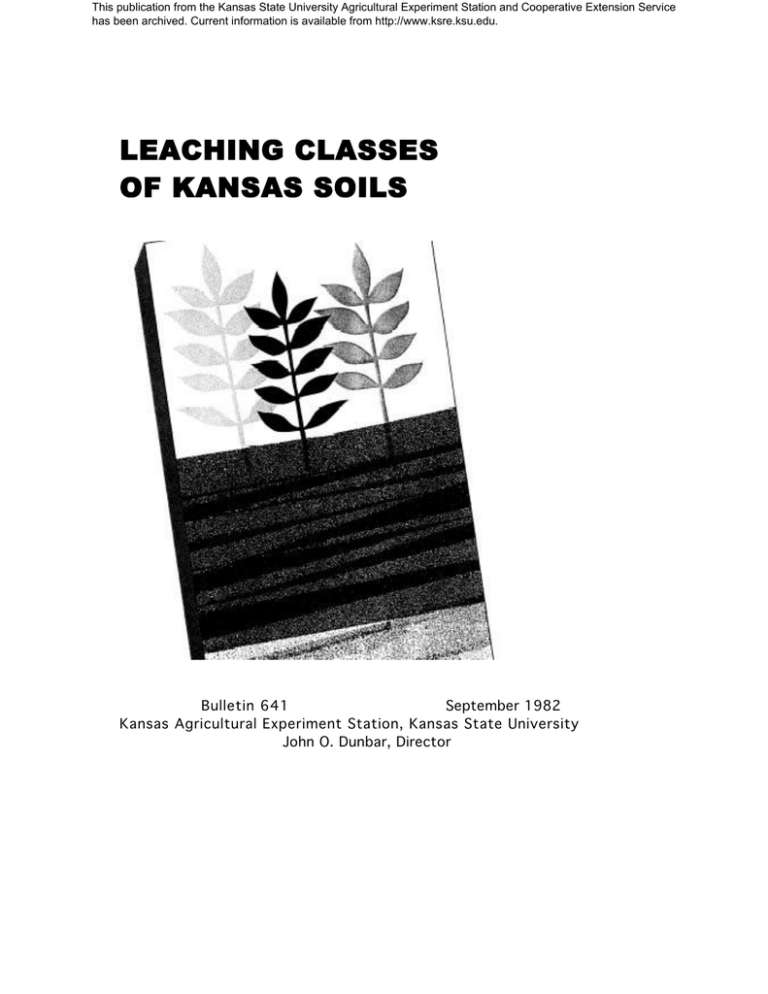
This publication from the Kansas State University Agricultural Experiment Station and Cooperative Extension Service has been archived. Current information is available from http://www.ksre.ksu.edu. LEACHING CLASSES OF KANSAS SOILS Bulletin 641 September 1982 Kansas Agricultural Experiment Station, Kansas State University John O. Dunbar, Director This publication from the Kansas State University Agricultural Experiment Station and Cooperative Extension Service has been archived. Current information is available from http://www.ksre.ksu.edu. Bulletin 641 Kansas Agricultural Experiment Station John O. Dunbar, director September 1982 Contribution 82-416-B, Department of Agronomy This publication from the Kansas State University Agricultural Experiment Station and Cooperative Extension Service has been archived. Current information is available from http://www.ksre.ksu.edu. Leaching Classes of Kansas Soils D. E. KISSEL Soil Fertility Scientist O. W. BIDWELL Soil Survey Research Scientist J. F. KIENTZ Research Associate Nitrate is the primary nitrogen compound that leaches since it is not adsorbed by soil colloids and dissolves readily in the soil water. Movement of water indicates movement of nitrate. In general, sandy soils are much more susceptible to leaching than clayey soils because they have less capacity to hold water and are more permeable. The amount and rate of water application, either from natural rainfall or applied irrigation water, can also influence the amount of water that drains through a soil and therefore the amount of nitrate that moves with the water. Finally, if more nitrate is present in the soil, leaching loss is potentially greater. The problem for the farmer is to maintain maximum yields of crops while minimizing nitrogen loss due to nitrate leaching. These two objectives are sometimes difficult to keep in balance. Sufficient nitrogen must be applied early in the season to get the crop off to a good start. Yet, applying the crop’s total season nitrogen-fertilizer needs may not be desirable in those situations where nitrate leaching is possible. Applying nitrogen fertilizer at the economic optimum amount per acre (rate per acre) is essential for the farmer to attain a profitable return. Application of nitrogen at rates greater than the economic optimum may waste nitrogen, potentially pollute groundwater supplies, and be an unnecessary expense. A nitrogen rate less than the economic optimum would result in a reduced crop yield and lower economic return. Attaining the economic optimum rate of nitrogen fertilizer is complicated by the potential for plant-available nitrogen to be lost from the soil. Losses of nitrogen cannot be predicted at the time of application since they depend in part on the unpredictable climate, particularly rainfall. Nitrogen Loss by Leaching Loss of available nitrogen (as nitrate) by leaching is one way in which nitrogen-fertilizer efficiency is reduced. Nitrate leaching is the downward movement of nitrate with water that drains through the soil. Loss by leaching implies that nitrate is irreversibly lost for crop uptake by moving below the deepest zone of water uptake by roots. The amount of nitrate leached in any situation depends on soil properties, amount of water draining through the soil, and the amount of nitrate in the soil. Nitrification Affects Nitrogen Loss Most commercial nitrogen fertilizer is applied as ammoniacal nitrogen. Ammoniacal nitrogen is not sub3 This publication from the Kansas State University Agricultural Experiment Station and Cooperative Extension Service has been archived. Current information is available from http://www.ksre.ksu.edu. Figure 1. Consider carefully the water and nitrogen management in irrigated corn production. ject to leaching, but does convert rapidly to nitrate by the process of nitrification under favorable conditions. Nitrification is slowed by low pH, low temperature, and dry soil conditions. In addition, some chemicals such as Nitrapyrin (sold by Dow Chemical Corp., with trade name N-SERVE) and Etradiazole (sold by Olin Corp., with trade name DWELL)* can slow nitrification and therefore potentially reduce nitrate-leaching losses since a greater proportion of the nitrogen fertilizer would remain as ammonium during the early part of the growing season. Nitrate-leaching losses occur most readily from coarse textured soils. These losses can be reduced by applying enough nitrogen to start the crop and then apply- ing the remainder of the nitrogen after the crop has emerged when conditions favoring leaching have passed. In the case of fall seeded small grains, nitrogen fertilizer can be “topdressed” in late winter or early spring. For spring seeded crops such as corn or sorghum, part of the nitrogen can be sidedressed, usually within 30 to 45 days after emergence. In both cases, delaying application of some of the nitrogen reduces nitrate losses during the early part of the growing season. An alternative to delayed nitrogen applications would be to apply all nitrogen preplant but with a nitrification inhibitor that reduces the conversion of ammonium to nitrate. Such applications reduce leaching losses since ammonium does not easily leach through the soil. In summary, nitrate leaching can be reduced by proper management of one or more of the following practices. *Trade names are used to help identify products. No endorsement is intended. 4 This publication from the Kansas State University Agricultural Experiment Station and Cooperative Extension Service has been archived. Current information is available from http://www.ksre.ksu.edu. Figure 2. Side dress application of nitrogen may improve efficiency of nitrogen use on some soils. 1. Apply nitrogen fertilizer closer to the time actually needed by the crop. Later application of part of the nitrogen can be accomplished by split application with “sidedressing” or “topdressing” operations, or by putting a portion of nitrogen onto the crop with irrigation water later in the growing season as needed (fertigation). 2. Delay the nitrification of fertilizer nitrogen. Since ammonium does not leach appreciably, slowing the conversion of ammonium to nitrate can reduce nitrogen-leaching losses. This is accomplished most often by the use of chemicals that inhibit nitrification. 3. Carefully manage irrigation amounts and frequency to help minimize drainage of water and nitrates below the root zone. This publication evaluates the potential for nitrate leaching from major agricultural soils in Kansas. While we recognize that rainfall amounts decrease considerably from east to west, climatic interaction was beyond the scope of this evaluation. Also, peak rainfall occurs during the May-July period throughout Kansas. Heavy rainstorms are likely during this period even in western Kansas where total annual rainfall is considerably less than in eastern Kansas. Influence of Soils on Leaching Those soils most susceptible to leaching also happen to be those that are most often irrigated. Irrigation produces important leaching losses regardless of whether the soils occur in the eastern or western part of the state. Heavy rain in the May-July period is most likely to cause leaching losses on spring seeded crops since wheat will have taken up a major portion of its nitrogen by midMay. However, heavy rains do sometimes occur at other times of the year and can have an impact on wheat production as well, particularly on coarse textured soils. The soils listed in Table 1 are arranged into four classes of leaching potential. They are described as: Class I. Some leaching losses of fertilizer N is likely most years. Response to N management is likely most years. Some leaching losses of fertilizer N may ocClass II. cur in some years. Response to N management is likely some years. Class III. Small leaching losses may occur occasionally. Response to N management is unlikely most years. Class IV. Leaching losses are insignificant. Response to N management is highly unlikely. 5 This publication from the Kansas State University Agricultural Experiment Station and Cooperative Extension Service has been archived. Current information is available from http://www.ksre.ksu.edu. The finest textured horizon of the profile was used to determine the soil’s class based on texture. For example, if a surface soil was a sandy loam, and the subsoil a loam, then the subsoil would place the series in Class III. Class determinations based on soil texture were modified where necessary according to permeability. The permeability of the four respective classes was as follows: inches per hour 6-20 Permeability Class I. inches per hour 2-6 Permeability Class II. Nitrogen management as used here means nitrogen management to reduce nitrate-leaching losses during the growing season by split applications of nitrogen fertilizer, ‘‘fertigation” according to crop need or use of nitrification inhibitors as described. Soils were placed into the four classes on the basis of soil texture and soil permeability to water. With regard to textural classification, classes were assigned as follows: Sands, fine sands, coarse sands, Textural Class I. and loamy coarse sands. Loamy fine sand, coarse sandy Textural Class II. loam, and sandy loam. Textural Class III. Loam, very fine sandy loam, silt loam, and fine sandy loam. Textural Class IV. Clay loam, silty clay loam, silty clay, sandy clay, and clay. inches per hour Permeability Class III. 0.6-2 Permeability Class IV. Less than 0.6 inches per hour The permeability of the most-limiting layer (lowest permeability) was used to determine leaching class according to permeability alone. For example, a soil whose top layer had a permeability of 10 inches per hour and Figure 3. Chart showing the percentages of clay (below 0.002 mm), silt (0.002 to 0.05mm), and sand (0.05 to 2.0 mm) in the basic soil textural classes. 6 This publication from the Kansas State University Agricultural Experiment Station and Cooperative Extension Service has been archived. Current information is available from http://www.ksre.ksu.edu. Figure 4. A Naron fine sandy loam located in Rice County: 0-14 inches fine sandy loam, 14-40 sandy clay loam, and 40-60 fine sandy loam. (Soil Conservation Service photo) Figure 5. A Smolan silty clay loam located in Rice County: 0-13 inches silty clay loam and 13-60 inches silty clay. (Soil Conservation Service photo) whose subsoil had a permeability of 4 inches per hour would be placed in Class II. The final class determination was then based on the factor most limiting to nitrate-leaching losses, either texture or permeability. For example, a sand (Textural Class I) with a permeability of between 2 and 6 inches per hour would be in Class II on the basis of its reduced permeability. If a soil, however, was classified as Textural Class III, yet was in Permeability Class II, it would still be classified as a Class III soil since Class III is less leachable. The major factor for class determination then was the amount of water that would need to be displaced through the soil profile before leaching losses occurred. On the other hand, if a soil was fairly coarse textured, but contained an impermeable layer that restricted moisture movement, then the impermeable layer became the dominant influence. An initial attempt was made to classify only those soils with more than approximately 50,000 mapped acres that were published in Soil Survey Reports through May 1981. However, some soils with less acreage were placed in the classification when they were known to have a high percentage of their acreage cultivated and, particularly, if these low-acreage soils were Class I or II soils. Since complete soil survey reports are not available for all Kansas counties, only those counties with published soil surveys as of May 1981 (Figure 6) were included in our analysis. The counties with published soil surveys were the majority of Kansas counties, representing 34 million acres of the total of 50 million acres in Kansas. The total acres of the four classes in Table 1 was 31 million acres, or about 91% of the 34 million acres surveyed. From these evaluations, we developed a general map showing the leaching classes of soils in Kansas according to area of the state. In general, the map indicates that the majority of Class I and II soils are located in south central and southwest Kansas. Exceptions to the location of Class I and II soils are the river valleys throughout Kansas where agriculturally important Class I and II soils are found. The acreages of the soils are relatively small but nevertheless important. Unfortunately, this detail could not be shown on the general map in Figure 7. 7 This publication from the Kansas State University Agricultural Experiment Station and Cooperative Extension Service has been archived. Current information is available from http://www.ksre.ksu.edu. Figure 6. Shaded areas indicate Kansas counties with published soil survey reports as of May 1981 whose acreages are represented in Table 1. Copies can be obtained from your County Extension Office or the Soil Conservation Service. 8 This publication from the Kansas State University Agricultural Experiment Station and Cooperative Extension Service has been archived. Current information is available from http://www.ksre.ksu.edu. Table 1. Nitrogen-leaching susceptibilities of Kansas Soils. Class I. Some leaching losses of fertilizer N in most years. Class Il. Some leaching losses of fertilizer N in some years. Class Ill. Light leaching losses occasionally. Class IV. Leaching losses are insignificant. SCS 2/ Major Land Resource Area 1/ Soil Series Permeability (Inches/Hr) Hydrologic Group Acres Subgroup Family Class I 72, 77, 78, 78, 79, 80, 74, 75, 76, 108, 115 72, 73, 77, Lincoln Pratt Sarpy Tivoli 80 73, 75 106, 107, 6-20 6-20 6-20 78, 79, 80 6-20 Total Acres = 83,700 594,900 21,000 Typic Ustifluvents Psammentic Haplustalfs Typic Udipsamments 511,000 Typic Ustipsamments Sandy, Mixed, Thermic Sandy, Mixed, Thermic Mixed, Mesic Mixed, Thermic 1,210,600 Class II. 2-6 2-6 2-6 0.6-2 201,300 99,100 96,500 24,000 75, 79, 80 64, 65, 66, 71, 72, 102b 74, 75, 76, 107, 106 107, 102 6-20 2-6 0.6-2 0.6-2 51,700 25,000 32,000 22,000 Las Animas 69, 67, 72 0.6-2 Likes Lincoln 3/ Manter Naron Otero 77, 72, 67, 75, 67, 2-6 6-20 2-6 0.6-2 6-20 26,000 21,000 215,500 342,000 102.100 Typic Ustipsamments Typic Ustifluvents Aridic Argiustolls Udic Argiustolls Ustic Torriorthents 0.6-2 0.6-2 2-6 23,000 200,000 297,500 Mollic Fluvaquents Udic Argiustolls Ustollic Haplargids Sandy, Mixed, Fine-Loamy, Mixed, Coarse-Loamy, Mixed, Entic Haplustolls Typic Argiudolls Fluventic Haplustolls Typic Calciustolls Typic Argiudolls Fine-Loamy, Fine-Loamy, Fine-Silty, Fine-Loamy, Fine-Silty, Fine-Silty, Mixed, Albion Attica Canadian Carr 75, 78, 80, 74, Dillwyn Elsmere Eudora 3/ Haynie Platte Shellabarger Vona 3/ 78, 79, 80 79, 80 78 75, 106, 107 78 77, 78, 80 72, 49, 70 78, 79, 80 69 67, 71, 72, 73, 75 74, 75, 76, 78, 79, 80 67, 72, 60, 61 Total Acres Class III. Armo Bates Bridgeport Campus Catoosa 40,000 72, 73, 74 76, 112 72, 73, 74, 63, 66, 65 72, 73 112, 85 Udic Udic Udic Typic Argiustolls Haplustalfs Haplustolls Udifluvents Coarse-Loamy, Coarse-Loamy, Coarse-Loamy, Coarse-Loamy, Mixed, Mixed, Mixed, Mixed, Aquic Ustipsamments Aquic Haplustolls Fluventic Hapludolls Mollic Udifluvents Mixed, Sandy, Mixed, Coarse-Silty, Mixed, Coarse-Silty, Mixed, Typic Coarse-Loamy, Mixed, Sandy, Coarse-Loamy, Fine-Loamy, Coarse-Loamy, Mixed, Mixed, Mixed, Mixed, Mixed, Fluvaquents Thermic Thermic Thermic (Calcareous), Mesic Thermic Mesic Mesic (Calcareous), Mesic (Calcareous), Mesic Thermic Thermic Mesic Thermic (Calcareous), Mesic Mesic Thermic Mesic = 1,766,800 0.2-0.6 0.6-2 0.6-2 0.6-2 0.6-2 164,800 127,200 200,600 77,400 156,500 Claremont 78 0.6-2 45,800 Typic Ustifluvents Clark Colby 75, 78, 79, 80 72, 77, 67, 64, 60, 61 0.6-2 0.6-2 95,900 779,000 Typic Ustic Calciustolls Torriorthents Coly 71, 72, 73, 75 0.6-2 72,500 Typic Ustorthents Dale Dalhart Elandco Elkader Eudora Farnum Geary Goshen Grant Hobbs 80, 84 77, 78 80, 84 72 106, 74, 75, 76, 107 75, 78, 79, 80 71, 74, 75, 76, 102, 73 64, 67, 72, 73 80 71, 73, 74, 75, 76, 102 0.6-2 0.6-2 0.6-2 0.6-2 0.6-2 0.6-2 0.2-0.6 0.6-2 0.6-2 0.6-2 Holdrege Hord Humbarger Ivan Keith Kennebec 0.6-2 0.6-2 0.6-2 0.6-2 0.6-2 0.6-2 Kim 71, 73, 74, 75, 65 63, 65, 71, 72, 73, 75 73, 74, 75 76, 106, 112 60, 61, 64, 67, 72, 73 76, 102, 103, 104. 105. 106, 107 67, 69, 72, 60, 61 0.2-0.6 48,500 Knox Kuma Lancaster Lula Marshall Mason McCook Milan Monona Muir Nashville Nuckolls Penden Plevna Pond Creek Port 106, 107, 115 67, 72 74, 75 112 102, 106, 107, 109 112 67, 72, 73 75, 80 107 74, 75, 76, 106, 112 80 71, 73, 74, 75 72, 73 75, 78, 79, 80 80 78, 79, 8O 0.6-2 0.6-2 0.6-2 0.6-2 0.6-2 0.2-0.6 0.6-2 0.2-0.6 0.6-2 0.6-2 0.6-2 0.6-2 0.6-2 2-6 0.2-0.6 0.6-2 64,100 92,500 42,500 60,700 57,600 61,300 55,700 108,900 104,900 111,600 57,400 65,300 248,200 57,400 89,900 58,600 97,900 296,000 41,400 64,600 32,000 691,300 205,200 161,900 115,300 170,500 420,100 183,600 52.100 82,400 1,276,000 174,700 Mixed, Mesic Siliceous, Thermic Mixed, Mesic Mixed, Mesic Mixed, Thermic Typic Argiustolls Cumulic Haplustolls Cumulic Haplustolls Cumulic Hapludolls Aridic Argiustolls Cumulic Hapludolls (Calcareous), Thermic Fine-Loamy, Mixed, Thermic Fine-Silty, Mixed, (Calcareous), Mesic Fine-Silty, Mixed, (Calcareous), Mesic Fine-Silty, Mixed, Thermic Fine-Loamy, Mixed, Mesic Fine-Silty, Mixed, Thermic Fine-Silty, Carbonatic, Mesic Coarse-Silty, Mixed, Mesic Fine-Loamy, Mixed, Thermic Fine-Silty, Mixed, Mesic Fine-Silty, Mixed, Mesic Fine-Silty, Mixed, Thermic Fine-Silty, Mixed, Non-Acid, Mesic Fine-Silty, Mixed, Mesic Fine-Silty, Mixed, Mesic Fine-Loamy, Mixed, Mesic Fine-Silty, Mixed, Mesic Fine-Silty, Mixed, Mesic Fine-Silty, Mixed, Mesic Ustic Fine-Loamy, Pachic Haplustolls Aridic Haplustalfs Cumulic Haplustolls Torriorthentic Haplustolls Fluventic Hapludolls Pachic Argiustolls Udic Argiustolls Pachic Argiustolls Udic Argiustolls Mollic Ustifluvents Torriorthents Mollic Hapludalfs Pachic Argiustolls Udic Argiustolls Typic Argiudolls Typic Hapludolls Typic Argiudolls Fluventic Haplustolls Udic Argiustolls Typic Hapludolls Cumulic Haplustolls Udic Haplustolls Typic Haplustolls Typic Calciustolls Fluvaquentic Haplaquolls Pachic Argiustolls Cumulic Haplustolls Mixed, (Calcareous), Mesic Fine-Silty, Mixed, Mesic Fine-Silty, Mixed, Mesic Fine-Loamy, Mixed, Mesic Fine-Silty, Mixed, Thermic Fine-Silty, Mixed, Mesic Fine-Silty, Mixed, Thermic Coarse-Silty, Mixed, Mesic Fine-Loamy, Mixed, Thermic Fine-Silty, Mixed, Mesic Fine-Silty, Mixed, Mesic Fine-Silty, Mixed, Thermic Fine-Silty, Mixed, Mesic Fine-Loamy, Mixed, Mesic Coarse-Loamy, Mixed, Thermic Fine-Silty, Mixed, Thermic Fine-Silty, Mixed, Thermic 1/ Major Land Resource Area, Agriculture Handbook 296, Soil Conservation Service, USDA. 2/ SCS Hydrologic Groups. A through D represent soil infiltration on a bare soil after prolonged wetting. Soil A is most permeable with D being least permeable. 3/ 51% of Eudora is Class II, and 50% is in Class III. Eudora silt loams are Class III. Eudora overwash (fine sandy loam complexes are Class II. 80% of Lincoln is in Class I, and 20% is in Class II. Lincoln loamy sands and fine sandy loams are Class II. The rest are Class I. All sandy loams and loamy fine sands are Class II. Fine sandy loams are Class III. 45% of Shellabarger is Class II, and 55% is Class III. 9 This publication from the Kansas State University Agricultural Experiment Station and Cooperative Extension Service has been archived. Current information is available from http://www.ksre.ksu.edu. Table 1. Continued Major Land Resource Area Soil Series Class III , Permeability (Inches/Hr) SCS Hydrologic Group Acres SubGroup Family cont’d. Quinlan Roxbury Satanta Shellabarger Sibleyville Uly Ulysses 78, 80 72, 73, 74, 60, 61, 64, 74, 75, 76, 106, 112 71, 72, 73, 60, 64, 67, Vanoss Verdigris Waldeck Woodward 80 112, 76 75, 78, 79, 80 78, 77 75 67, 72, 77 78, 79, 80 75, 65 72, 77 0.6-2 0.6-2 0.2-0.6 0.6-2 0.6-2 0.6-2 0.6-2 C B B B B B B 77,200 400,700 70,900 250,100 42,500 499,400 2,651,000 0.6-2 0.6-2 2-6 0.6-2 B B C B 177,700 264,900 49,200 48,600 Total Acres = 12,473,700 0.06-0.2 0.2-0.6 0.06-O.2 0.6-2 0.06-0.2 0.2-2 0.06-0.6 0.06-0.6 0.06-0.6 0.2-0.6 0.06-0.2 < 0.06 0.06-0.6 0.2-0.6 0.2-0.6 < 0.06 0.2-0.6 0.2-0.6 0.2-0.6 < 0.06 < 0.06 < 0.06 0.06-0.2 < 0.06 0.2-0.6 0.6-2 0.06-0.2 0.06-0.2 2-6 0.06-0.2 0.2-0.6 < 0.06 0.06-0.2 0.2-0.6 < 0.06 0.06-0.2 0.6-2 < 0.06 0.2-2 0.2-0.6 0.2-6 < 0.06 < 0.06 0.6-2 0.2-0.6 0.06-0.2 0.06-0.2 0.2-0.6 < 0.06 0.06-0.2 < 0.06 < 0.06 C C C D C C C C D C C D C B C D C C B D D D C D C B C C B C B D C B D D B D C D C C D B B C C C D C D D 315,500 156,800 51,800 267,600 53,100 104,600 477,000 54,100 688,600 269,800 73,000 263,700 52,800 49,800 153,300 43,400 215,200 2,704,600 168,100 853,300 419,600 96,200 396,900 244,600 42,400 221,400 490,800 89,500 63,600 48,600 76,000 81,400 60,500 43,500 173,400 491,500 60,000 49,700 150,100 97,100 2,743,800 42,300 99,500 79,8O0 154,300 109,700 303,800 47,300 177,000 197,900 117,600 73,000 0.6-2 < 0.06 0.06-0.2 < 0.06 0.6-2 B D D D C 180,600 274,300 306,300 173,800 40,000 Typic Ustochrepts Cumulic Haplustolls Aridic Argiustolls Udic Argiustolls Typic Argiudolls Typic Haplustolls Aridic Haplustolls Loamy, Mixed, Thermic, Shallow Fine-Silty, Mixed, Mesic Fine-Loamy, Mixed, Mesic Fine-Loamy, Mixed, Thermic Fine-Loamy, Mixed, Mesic Fine-Silty, Mixed, Mesic Fine-Silty, Mixed, Mesic Udic Argiustolls Cumulic Hapludolls Fluvaquentic Haplustolls Typic Ustochrepts Fine-Silty, Mixed, Thermic Fine-Silty, Mixed, Thermic Coarse-Loamy, Mixed, Thermic Coarse-Silty, Mixed, Thermic Pachic Paleustolls Pachic Argiustolls Pachic Argiustolls Typic Argiaquolls Aquic Argiudolls Typic Argiudolls Udic Haplustolls Typic Ustochrepts Pachic Argiustolls Aquic Paleudolls Pachic Argiustolls Typic Natrustolls Udic Argiustolls Typic Argiudolls Aquic Argiudolls Udic Pellusterts Aquic Argiudolls Typic Argiustolls Udic Argiustolls Pachic Argiustolls Vertic Argiudolls Udertic Paleustolls Udic Argiustolls Pachic Argiustolls Pachic Argiustolls Aridic Calciustolls Aquic Argiudolls Typic Argiustolls Typic Argiudolls Cumulic Haplustolls Udic Paleustolls Vertic Haplaquolls Typic Argiudolls Typic Argiustolls Mollic Albaqualfs Aquic Argiudolls Typic Argiudolls Udic Pellusterts Typic Argiudolls Udertic Paleustolls Aridic Argiustolls Entic Hapludolls Udertic Haplustolls Typic Argiudolls Typic Argiudolls Pachic Argiustolls Typic Argiustolls Vertic Argiudolls Vertic Argiustolls Pachic Argiustolls Typic Ustochrepts Vertic Haplaquolls Fine, Mixed, Thermic Fine, Mixed, Thermic Fine, Mixed, Thermic Fine, Mixed, Thermic Fine, Montmorillonitic, Mesic Clayey-Skeletal, Mixed, Thermic Fine, Mixed, Mesic Fine, Mixed, Mesic Fine, Montmorillonitic, Mesic Fine, Mixed, Thermic Fine, Montmorillonitic, Mesic Fine, Montmorillonitic, Mesic Fine, Mixed, Mesic Fine-Silty, Mixed, Mesic Fine, Mixed, Thermic Fine, Montmorillonitic, Mesic Fine, Montmorillonitic, Mesic Fine, Montmorillonitic, Mesic Fine, Montmorillonitic, Mesic Fine, Mixed, Mesic Fine, Montmorillonitic, Thermic Fine, Mixed, Thermic Fine, Mixed, Mesic Fine, Montmorillonitic, Mesic Fine, Mixed, Mesic Fine-Loamy, Mixed, Thermic Fine, Montmorillonitic, Mesic Fine, Montmorillonitic, Mesic Fine-Loamy, Mixed, Mesic Fine, Montmorillonitic, Mesic Fine-Silty, Mixed, Thermic Fine, Montmorillonitic, Thermic Fine, Montmorillonitic, Mesic Fine-Loamy, Mixed, Thermic Fine, Mixed, Thermic Fine, Montmorillonitic, Mesic Fine, Montmorillonitic, Mesic Fine, Montmorillonitic, Thermic Fine-Silty, Mixed, Mesic Fine, Mixed, Thermic Fine, Montmorillonitic, Mesic Fine, Mixed, Thermic Fine, Montmorillonitic, Mesic Fine, Montmorillonitic, Mesic Fine-Loamy, Mixed, Mesic Fine, Montmorillonitic, Mesic Fine, Montmorillonitic, Mesic Fine, Montmorillonitic, Thermic Fine, Montmorillonitic, Thermic Fine, Mixed, Mesic Fine, Mixed, Thermic Fine, Montmorillonitic, Mesic Entic Haplustolls Abruptic Argiaquolls Aquic Argiudolls Vertic Hapludolls Fluvaquentic Haplustolls Fine, Silty, Carbonatic, Mesic Fine, Montmorillonitic, Thermic Fine, Montmorillonitic, Mesic Fine, Montmorillonitic, Thermic Fine-Loamy, Mixed, Thermic Class IV. Bethany Blanket Brewer Carwile Chase Clareson Clime Corinth Crete Dennis Detroit Dwight Edalgo Elmont Eram Goessel Grundy Harney Hastings Irwin Kenoma Kirkland Labette Ladysmith Lubbock Mansic Martin Mento Morrill New Cambria Norge Osage Oska Ost Parsons Pawnee Polo Randall Reading Renfro Richfield Ringo Rosehill Sharpsburg Shelby Smolan Spearville Summit Tabler Tully Vernon Wabash Wakeen Woodson Wymore Zaar Zenda 80 78, 80, 84, 85 80 78, 80 76, 106, 112 112 75, 76 72, 73 75, 106, 74 112 72, 73, 74, 75 75, 76, 106, 112 74 76, 106 112 75 106, 107, 108, 109, 112 72, 73 71, 73, 74, 75, 76 75, 76 112, 76 80 76, 112 74, 75, 76 72, 79 77. 78 106, 112, 76 73 106, 75 73, 74 80, 84 112, 75 106, 107, 112 78, 79, 80 112 106 107, 109, 112 77, 78 76, 106, 112 80 72 112 75 106, 107, 108, 109, 112 106, 107, 108, 109, 115 74, 75, 76 72, 77 112 80 74, 75, 76 78 106, 107, 108, 109, 113, 114 72, 73, 75 112 75, 76, 106 112, 76 78, 79, 80 Total Acres = 15,532,800 10 This publication from the Kansas State University Agricultural Experiment Station and Cooperative Extension Service has been archived. Current information is available from http://www.ksre.ksu.edu.
